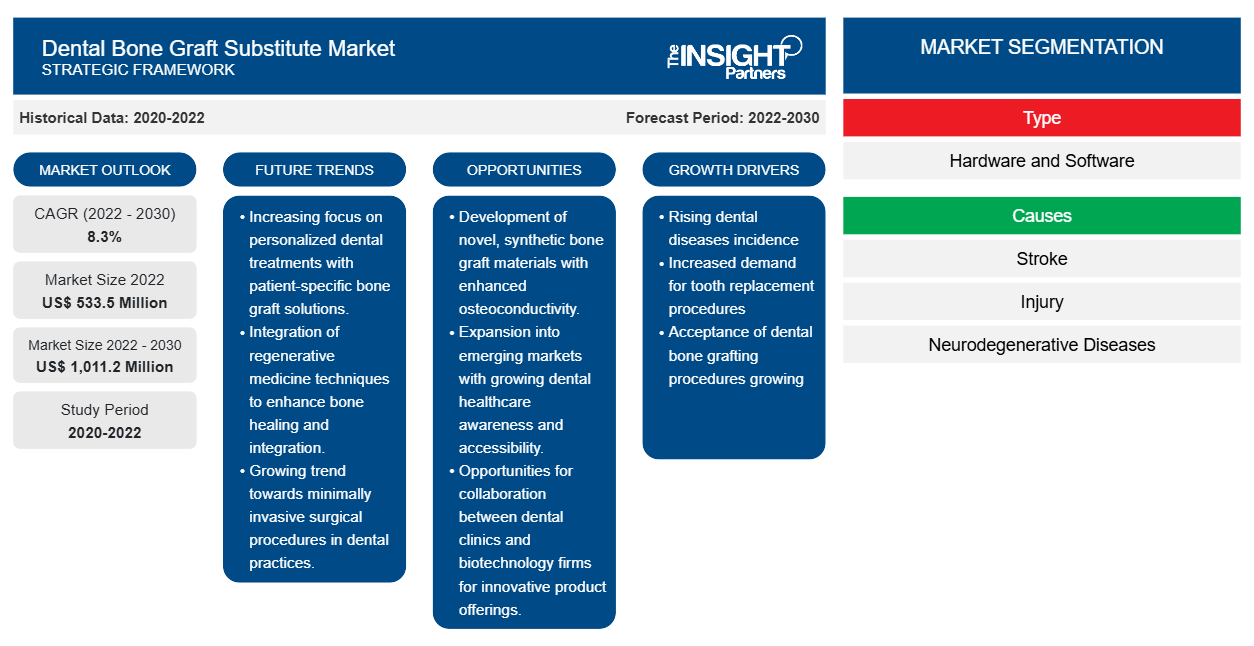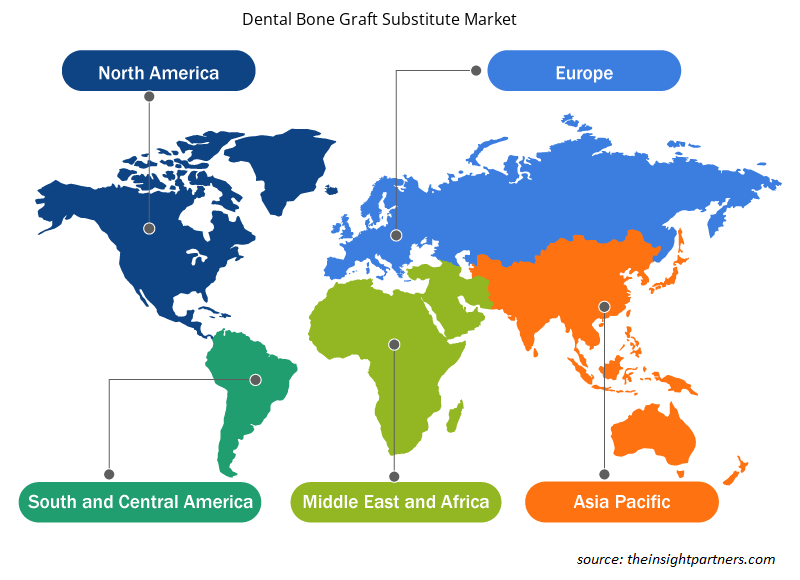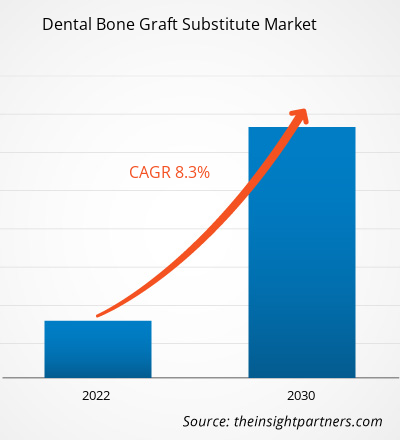[Informe de investigación] El mercado de sustitutos de injertos óseos dentales alcanzó los 623,20 millones de dólares estadounidenses en 2024 y se proyecta que alcance los 1.098,48 millones de dólares estadounidenses en 2031. Se espera que registre una tasa de crecimiento anual compuesta (TCAC) del 7,21 % entre 2025 y 2031.
Perspectivas del mercado y opinión de los analistas:
El mercado de sustitutos de injertos óseos dentales está creciendo rápidamente debido al creciente número de enfermedades dentales y al incremento de procedimientos dentales por motivos estéticos. La creciente prevalencia de enfermedades dentales y la introducción de iniciativas gubernamentales de apoyo a los sustitutos de injertos óseos dentales se encuentran entre los impulsores de crecimiento más duraderos de este mercado. Estos sustitutos de injertos óseos también se utilizan en procedimientos dentales cosméticos, lo que explica su notable demanda, especialmente en países de altos ingresos.
Factores impulsores del crecimiento y desafíos:
La creciente carga de enfermedades periodontales y cáncer oral, y la creciente demanda de procedimientos cosméticos dentales impulsan el crecimiento del mercado de sustitutos de injerto óseo dental. Las enfermedades bucales son altamente prevenibles. Sin embargo, estas enfermedades constituyen importantes problemas de salud en muchos países y afectan a las personas a lo largo de su vida. Varios problemas dentales comunes incluyen enfermedades periodontales, caries dentales y pérdida de piezas dentales. La creciente prevalencia de enfermedades dentales está provocando la necesidad de reemplazo de piezas dentales, coronas dentales , cofias y puentes dentales. Según el Informe sobre el Estado de la Salud Bucodental Mundial (2022) de la Organización Mundial de la Salud (OMS), aproximadamente 3 de cada 4 personas se ven afectadas por enfermedades bucodentales a nivel mundial, de las cuales aproximadamente 3.500 millones viven en países de ingresos medios. Además, aproximadamente 2.000 millones de personas en todo el mundo padecen caries dental en dientes permanentes y alrededor de 514 millones de niños padecen caries en dientes primarios. La creciente tasa de prevalencia de problemas dentales como dientes torcidos, sobremordidas, espacios interdentales y apiñamiento dental está generando una demanda de sustitutos de injerto óseo dental para tratar dichos problemas. Por ejemplo, según los Centros para el Control y la Prevención de Enfermedades (CDC), en EE. UU., aproximadamente el 47,2 % de los adultos mayores de 30 años padecen alguna enfermedad periodontal, la cual aumenta con la edad; y aproximadamente el 70,1 % de los adultos mayores de 65 años padecieron enfermedad periodontal en 2020. Este creciente número de personas que padecen enfermedades dentales está impulsando la demanda de sustitutos de injerto óseo dental para un tratamiento fácil y rápido. Por lo tanto, el aumento de la prevalencia de enfermedades bucodentales a nivel mundial está impulsando el crecimiento del mercado.
Se espera que la digitalización de la odontología con tecnología CAD/CAM traiga nuevas tendencias al mercado de sustitución de injertos óseos dentales en los próximos años.
Personalice este informe según sus necesidades
Recibirá personalización de cualquier informe, sin cargo, incluidas partes de este informe o análisis a nivel de país, paquete de datos de Excel, así como también grandes ofertas y descuentos para empresas emergentes y universidades.
Mercado de sustitutos de injertos óseos dentales: Perspectivas estratégicas

-
Obtenga las principales tendencias clave del mercado de este informe.Esta muestra GRATUITA incluirá análisis de datos, desde tendencias del mercado hasta estimaciones y pronósticos.
Segmentación y alcance del informe:
El análisis del mercado de sustitutos de injerto óseo dental se ha realizado considerando los siguientes tipos de segmento, aplicación, usuario final y geografía. El mercado, por tipo, se segmenta en autoinjerto, aloinjerto, xenoinjerto, injerto óseo sintético y otros. Según la aplicación, el mercado se segmenta en preservación del alvéolo, aumento de cresta, regeneración periodontal, regeneración ósea con implantes y elevación de seno. El mercado, por usuario final, se segmenta en hospitales, clínicas dentales y otros. Geográficamente, el alcance del informe de mercado de sustitutos de injerto óseo dental se divide principalmente en América del Norte (EE. UU., Canadá y México), Europa (España, Reino Unido, Alemania, Francia, Italia y el resto de Europa), Asia Pacífico (Corea del Sur, China, Japón, India, Australia y el resto de Asia Pacífico), Oriente Medio y África (Sudáfrica, Arabia Saudita, Emiratos Árabes Unidos y el resto de Oriente Medio y África), y América del Sur y Central (Brasil, Argentina y el resto de América del Sur y Central).
Análisis segmentario:
El mercado de sustitutos de injerto óseo dental, según el tipo, se segmenta en autoinjerto, aloinjerto, xenoinjerto, injerto óseo sintético y otros. En 2022, el segmento de autoinjerto tuvo la mayor participación en el mercado de sustitutos de injerto óseo dental. Se espera que el segmento de xenoinjerto registre la mayor tasa de crecimiento anual compuesta (TCAC) del mercado de sustitutos de injerto óseo dental entre 2022 y 2030. Los autoinjertos se obtienen comúnmente de sitios extraorales e intraorales, como la rama mandibular, la sínfisis mandibular, la cresta oblicua externa, el cúbito proximal, la cresta ilíaca o el radio distal, del paciente en tratamiento, ya que constituyen una buena fuente de hueso cortical y esponjoso. Los autoinjertos se asocian con mayores costos quirúrgicos e implican riesgos quirúrgicos significativos, como inflamación, sangrado excesivo, dolor e infección, lo que limita su aplicación a defectos óseos más pequeños. Aunque otros sustitutos óseos se utilizan rutinariamente para tratar defectos óseos alveolares localizados e injertos óseos maxilares en aplicaciones dentales, los autoinjertos en forma de bloque aún se utilizan rutinariamente en procedimientos de aumento de la cresta alveolar. Los autoinjertos son el material preferido para procedimientos de aumento complejos, como la reconstrucción edéntula mandibular posterior, porque solo unos pocos materiales de sustituto óseo pueden producir un volumen de hueso recién formado comparable a los materiales de autoinjerto. Los xenoinjertos son materiales de trasplante derivados de una especie genéticamente no relacionada del huésped. Los sustitutos óseos naturales promueven potenciales osteogénicos, osteoconductores y osteoinductivos mejorados al crear un microambiente favorable para el crecimiento óseo. La mayoría de los xenoinjertos derivados del ganado se esterilizan y procesan para una implantación segura en tejido humano. Estos xenoinjertos pueden liofilizarse o desmineralizarse y desproteinizarse. Los xenoinjertos generalmente se distribuyen solo como una matriz calcificada. Los corales madréporos y millepore se recolectan y procesan para obtener gránulos derivados de coral (CDG) y otros xenoinjertos de coral. A pesar de las prometedoras perspectivas de muchos materiales de xenoinjerto, el uso de sustitutos óseos para xenoinjertos aún presenta algunas limitaciones. Estas incluyen las tasas variables de reabsorción, la falta de células viables y componentes biológicos, y la necesidad de procesos de tratamiento tisular que permitan la retención de células osteoinductoras.
El mercado de sustitutos de injertos óseos dentales, por aplicación, se segmenta en preservación de alvéolos, aumento de cresta, regeneración periodontal , regeneración ósea con implantes y elevación de seno maxilar. En 2022, el segmento de preservación de alvéolos tuvo la mayor cuota de mercado y se prevé que registre la mayor tasa de crecimiento anual compuesta (TCAC) entre 2022 y 2030.
El mercado, por usuario final, se segmenta en hospitales, clínicas dentales y otros. En 2022, el segmento de clínicas dentales tuvo la mayor cuota de mercado de sustitutos de injertos óseos dentales y se espera que registre la mayor tasa de crecimiento anual compuesta (TCAC) entre 2022 y 2030.
Análisis regional:
Geográficamente, el mercado se divide en América del Norte, Europa, Asia Pacífico, Oriente Medio y África, y América del Sur y Central. América del Norte es el mayor contribuyente al crecimiento del mercado global de sustitutos de injerto óseo dental. Se prevé que Asia Pacífico presente la mayor tasa de crecimiento anual compuesta (TCAC) del mercado durante el período 2022-2030. En los últimos 20 años, se han producido cambios significativos en la práctica odontológica en EE. UU. Según un informe de los CDC, uno de cada cuatro adultos (26 %) en EE. UU. presenta caries sin tratar. Además, casi la mitad (~46 %) de los adultos mayores de 30 años presenta signos de enfermedad periodontal, la cual afecta a aproximadamente el 9 % de los adultos en estado grave. Asimismo, los avances tecnológicos en odontología ofrecen numerosas ventajas para facilitar el trabajo de los dentistas y de los usuarios de servicios dentales, cada vez más exigentes en cuanto a estética.CAGR in the market during 2022–2030. Significant changes have occurred in dental practice over the past 20 years in the US. As per the CDC report, 1 in 4 (26%) adults in the US have untreated tooth decay. Additionally, nearly half (~46%) of all adults aged 30 years or older show signs of gum disease, severe gum disease affecting about 9% of adults. Furthermore, technological advancements in dentistry provide numerous advantages for facilitating the work of dentists and users of dental services that are becoming more demanding in terms of aesthetics.
Perspectivas regionales del mercado de sustitutos de injertos óseos dentales
Los analistas de Insight Partners han explicado detalladamente las tendencias y los factores regionales que influyen en el mercado de sustitutos de injertos óseos dentales durante el período de pronóstico. Esta sección también analiza los segmentos y la geografía del mercado de sustitutos de injertos óseos dentales en América del Norte, Europa, Asia Pacífico, Oriente Medio y África, y América del Sur y Central.

- Obtenga datos regionales específicos para el mercado de sustitutos de injertos óseos dentales
Alcance del informe de mercado de sustitutos de injertos óseos dentales
| Atributo del informe | Detalles |
|---|---|
| Tamaño del mercado en 2024 | US$ 623,20 millones |
| Tamaño del mercado en 2031 | US$ 1.098,48 millones |
| CAGR global (2025-2031) | 7,21% |
| Datos históricos | 2021-2023 |
| Período de pronóstico | 2025-2031 |
| Segmentos cubiertos |
Por tipo
|
| Regiones y países cubiertos |
América del norte
|
| Líderes del mercado y perfiles de empresas clave |
|
Densidad de actores del mercado de sustitutos óseos dentales: comprensión de su impacto en la dinámica empresarial
El mercado de sustitutos de injertos óseos dentales está en rápido crecimiento, impulsado por la creciente demanda del usuario final debido a factores como la evolución de las preferencias del consumidor, los avances tecnológicos y un mayor conocimiento de los beneficios del producto. A medida que aumenta la demanda, las empresas amplían su oferta, innovan para satisfacer las necesidades del consumidor y aprovechan las tendencias emergentes, lo que impulsa aún más el crecimiento del mercado.
La densidad de actores del mercado se refiere a la distribución de empresas o compañías que operan en un mercado o sector en particular. Indica cuántos competidores (actores del mercado) hay en un mercado determinado en relación con su tamaño o valor total.
Las principales empresas que operan en el mercado de sustitutos de injertos óseos dentales son:
- Dentsply Sirona Inc
- Dentium Co Ltd
- Geistlich Pharma AG
- ZimVie Inc
- Keystone Dental Inc
- Straumann Holding AG
Descargo de responsabilidad : Las empresas enumeradas anteriormente no están clasificadas en ningún orden particular.

- Obtenga una descripción general de los principales actores clave del mercado de sustitutos de injerto óseo dental
Desarrollos de la industria y oportunidades futuras:
El pronóstico del mercado de sustitutos óseos dentales se estima a partir de diversos hallazgos de investigación, tanto secundarios como primarios, como publicaciones de empresas clave, datos de asociaciones y bases de datos. A continuación, se enumeran las estrategias de los principales actores del mercado:
- En abril de 2023, ZimVie Inc. anunció el lanzamiento de dos productos: RegenerOss CC Allograft Particulate y RegenerOss Bone Graft Plug. El lanzamiento de estos productos amplía la cartera de biomateriales de ZimVie, Inc. para el relleno de alvéolos post-extracción y defectos periodontales. Los productos están disponibles comercialmente en Norteamérica.
Panorama competitivo y empresas clave:
Dentsply Sirona Inc., Dentium Co Ltd., Geistlich Pharma AG, ZimVie Inc., Keystone Dental Inc., Straumann Holding AG, Medtronic Plc., BioHorizons Inc., MEDOSIS y LifeNet Health Inc. se encuentran entre las empresas destacadas que se describen en el informe del mercado de sustitutos de injerto óseo dental. Además, se han estudiado y analizado otras empresas durante el estudio para obtener una visión integral del mercado y su ecosistema. Estas empresas se centran en la expansión geográfica y el lanzamiento de nuevos productos para satisfacer la creciente demanda de los consumidores a nivel mundial y ampliar su gama de productos especializados. Su presencia global les permite atender a una amplia base de clientes, lo que facilita la expansión del mercado.
- Análisis histórico (2 años), año base, pronóstico (7 años) con CAGR
- Análisis PEST y FODA
- Tamaño del mercado, valor/volumen: global, regional y nacional
- Industria y panorama competitivo
- Conjunto de datos de Excel
Informes recientes
Informes relacionados
Testimonios
Razón para comprar
- Toma de decisiones informada
- Comprensión de la dinámica del mercado
- Análisis competitivo
- Información sobre clientes
- Pronósticos del mercado
- Mitigación de riesgos
- Planificación estratégica
- Justificación de la inversión
- Identificación de mercados emergentes
- Mejora de las estrategias de marketing
- Impulso de la eficiencia operativa
- Alineación con las tendencias regulatorias






















 Obtenga una muestra gratuita para - Mercado de sustitutos de injertos óseos dentales
Obtenga una muestra gratuita para - Mercado de sustitutos de injertos óseos dentales